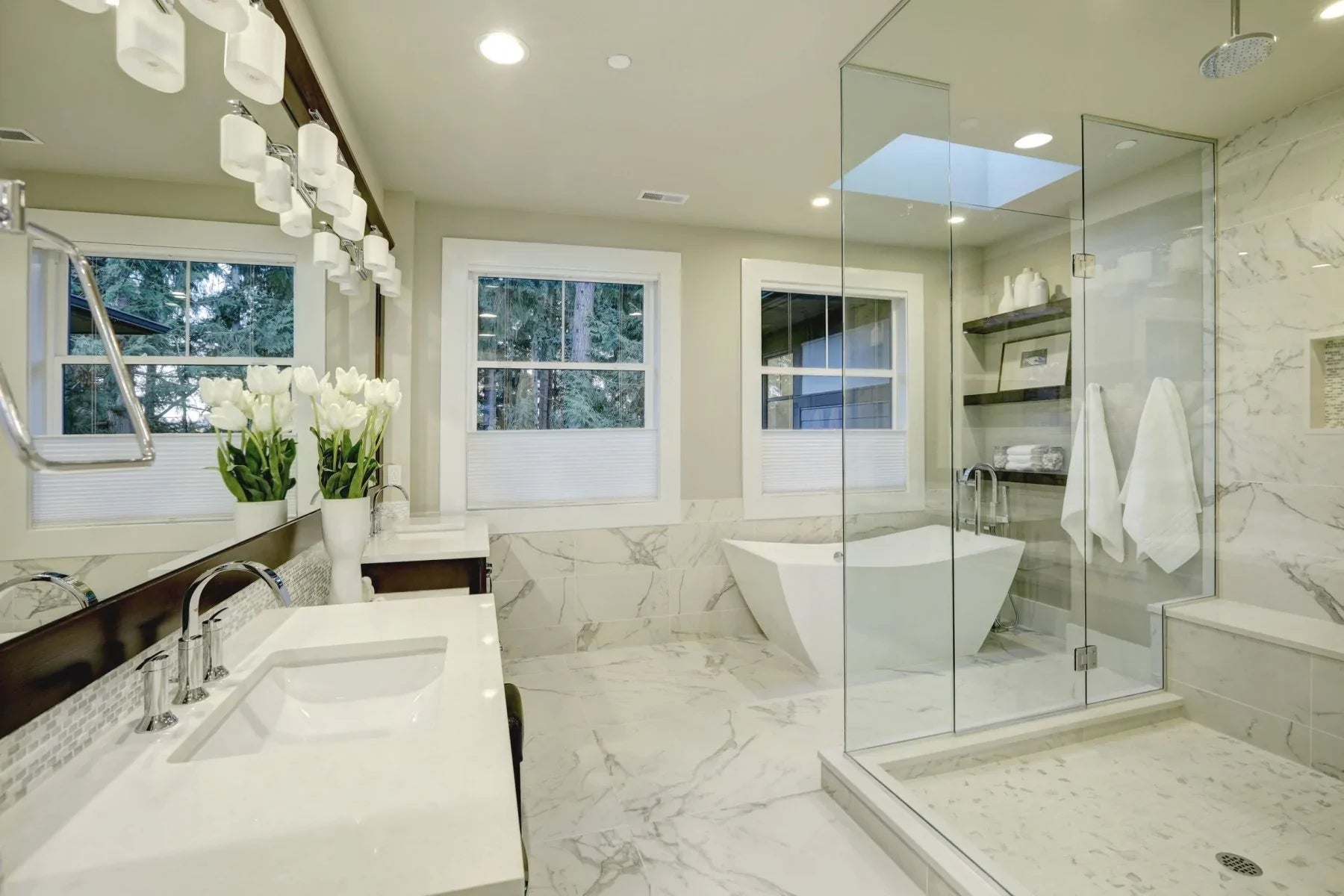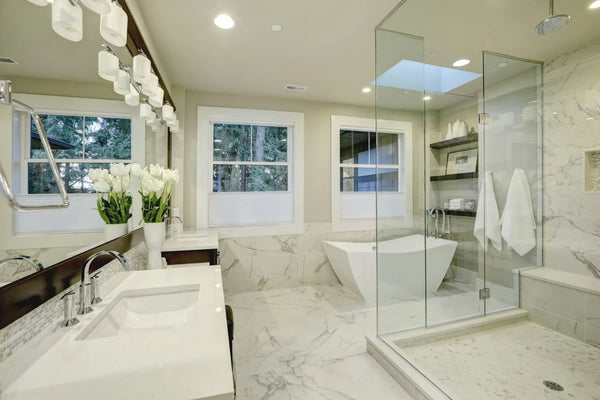If there’s one material that instantly elevates a bathroom from functional to luxurious, it’s marble. This polished stone has been used in bathrooms for many years because it’s both sturdy and beautiful. Plus, there’s a marble color and style for everyone. The following design tips will help you understand the most popular types of marble — and how to incorporate them into your bathroom.
Options for a Marble Bathroom
Marble is a metamorphic rock composed of several different materials. These often include pyrite, graphite and quartz, Katie Byrne at inspirational interiors website KBB Ark writes. Since marble can have so many compositions, it can also have many appearances. Some marbles have warm tones like peach and pink, while other varieties have a cooler look, with shades of blue and green.
White and pale marble varieties have a strong showing in minimalist, Scandinavian-inspired bathrooms and it’s becoming more popular across design styles. Blue and gray marble are some of the most common color swatches people reach for after white. Golden and green marbles create more dramatic looks, the stoneworks company Sky Marble explains.
Some designers are even pushing this trend to the extreme by opting for marble that’s extremely dark, even black. Nero Portoro, a black marble from Italy, is a coveted dark marble with its veins of gold. A bathroom in black marble looks chic, HGTV’s Erica Reitman adds. Black marble supports a high contrast color scheme and looks dramatic against a white toilet and bathtub.
Plus, marble is versatile enough to work with almost any design theme. Contemporary, traditional, modern and classic styles all cater well to marble bathroom elements, Anabelle Bernard Fournier at The Spruce writes. With so many options to choose from, homeowners won’t have any problem finding a marble that suits their color and design preferences.
Aesthetic benefits aside, marble is great because it’s a long-lasting choice for home renovations. In fact, interior designer Anna Morrow Braund believes that stones like marble are essential in a bathroom update because they won’t go out of style. “Marble or limestone is a timeless material and will stay in vogue no matter how old the bathroom is,” she says.
To reap the benefits of marble’s timeless beauty and resilience in your bathroom, here’s how to use this versatile material.

Using Marble in the Bathroom
Marble can be the primary design element in a bathroom. This is the case in a New York apartment showcased by Architectural Digest’s Allix Cott. The bathroom features marble across the walls, floor, countertop and backsplash. Chrome fixtures and black elements add a sophisticated touch.
Singapore Home Decor writer Domenica Tan shows how marble floors and walls can be paired with a glass shower to add space to a bathroom. When the marble used on a shower wall and floor isn’t obstructed by a shower curtain or opaque shower doors, light has more surface area to bounce around on. This makes the space brighter and more inviting.
See too how marble can be used uniquely in the shower by considering a project by Salt Design Co. Led by interior designer Sarah Brady, this custom shower installation uses small gold-flecked tiles to create a fish scale-inspired pattern. There’s also a horizontal built-in shelf that provides accessible storage while adding an interesting design element to the space.
The durable and resilient qualities of marble make it a great choice for bathroom flooring, too, Ozge Tirpan at marble supplier Sefa Stone notes. Marble floors are resistant to water damage and so will look new for a long time. Since each marble stone is unique, marble flooring can make a bathroom look more authentic as well. And, different cuts of marble can be assorted and mix-matched on the floor for a truly custom look.
Enjoying the long-lasting beauty of marble will require maintenance, however. Bernard Fournier says that marble must be sealed in order to maintain its appearance. Sealing marble with a slip-resistant finish can also make it safer, since it is normally quite slippery when wet.
Marble Countertops and Sinks
Marble is also a common material for bathroom countertops.
Elongated marble tops with drop down basins are easy to clean, real estate writer Remshay Ahmed explains. Marble tends to mask dirt better than other stones, due to its multicolored appearance. This makes marble countertops an especially beneficial choice for homes with busy families and children, which tend to require more frequent cleaning.
For a smaller bathroom, a compact marble sink might be the best option. Adam and Amber Ford at their design blog, The Happy Tudor, show how pedestal and floating sinks provide a place to wash and even keep a few things handy without taking up a large amount of space.
Marble slabs can always be cut to the exact size of your choosing, so don’t rule out the option of a customized marble sink. A marble sink highlighted by Remodelista’s Margot Guralnick shows just how unique a custom sink can look. This rectangular basin is paired with a stainless steel faucet and a mirror with a bronze border — a tasteful example of how marble can support mix-match color schemes.
Marble bathroom décor make it easy to incorporate the elegant material into your space with minimal investment. A marble soap dispenser, toothbrush holder or tissue box add a touch of luxe to the room, Aimee Connolly at The LuxPad writes. Marble accessories can adorn a countertop of a different material to add an elegant splash. Or, create a monochromatic look with marble accessories on a marble countertop. High-contrast design styles, where marble is paired with dark or black features, is another timeless scheme that works well in nearly any bathroom.

Pairing Marble with Wood and Metal
Decorating an entire bathroom in marble can sometimes feel too stark and cold. Fortunately, marble plays well when balanced with warmer, natural materials like wood. A bathroom showcased by interior designer Kylie Mawdsley shows how a marble, cool gray paint and a medium tone wood vanity work together in harmony. The wood in this bathroom also helps adds a homey and cozy touch to the cooler elements in the space.
Wood and marble also create a compelling contrast that’s equal parts elegant and rustic, sophisticated and approachable. According to La Maison Jolie founder Rani Engineer, marble inlaid in wood is a popular trend that many bathroom and kitchen designers are experimenting with.
White carrara marble is especially common in interior designs, she adds. This is because carrara often has silver and gold veining (the naturally-occurring color deposits in the stone), which compliments metal fixtures in the bathroom.
Aside from wood, the most popular marble pairing materials today include brick and metal, according to Mar Esteve Cortés at The Size, a surfacing material distributor. While silver metals exude a cooler feel, gold metals give a cozy and inviting to the space. The most popular trending combination for bathrooms is marble and copper.
Bronze is often paired with marble for a modern, sophisticated look. A freestanding tub is paired with bronze and marble, writer Warren Singh-Bartlett at Wallpaper notes. The white and gray marble flooring in this luxury hotel bathroom in Kuwait is complemented with contemporary mashrabiya screens, which provide a delicate privacy wall around the bathtub.
When tiles need to be repaired, grout can be a creative method, adding a decorative metallic touch. Metallic grout creates a wow effect, interior designer Anna Lysik explains. It echoes the streaks and lines that are naturally occuring in marble. When installing new marble tiles, metallic grout can be used instead of black or white grout as well.
Images by: iriana88w/©123RF Stock Photo, Greg Montani, piovesempre/©123RF Stock Photo






